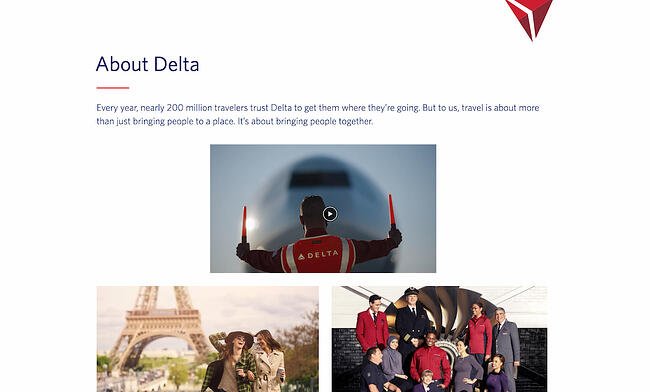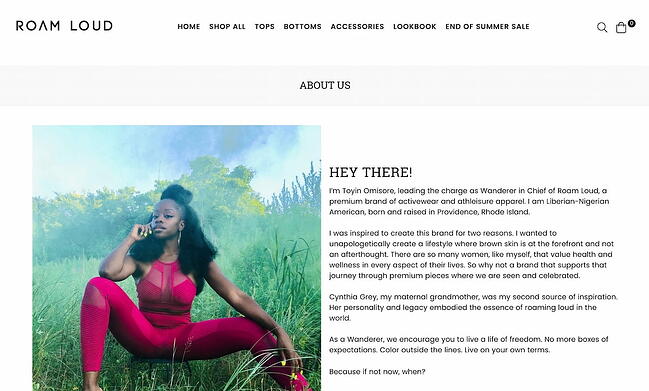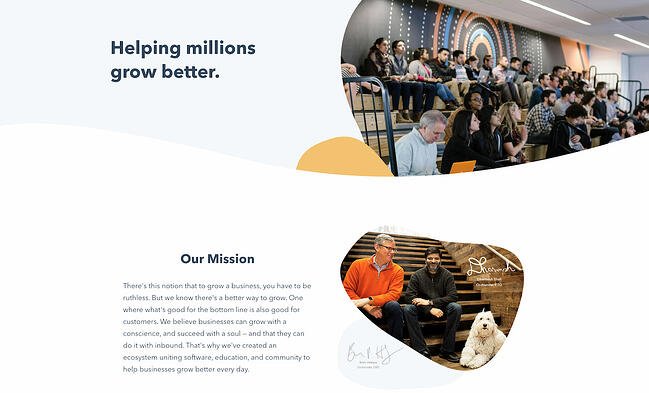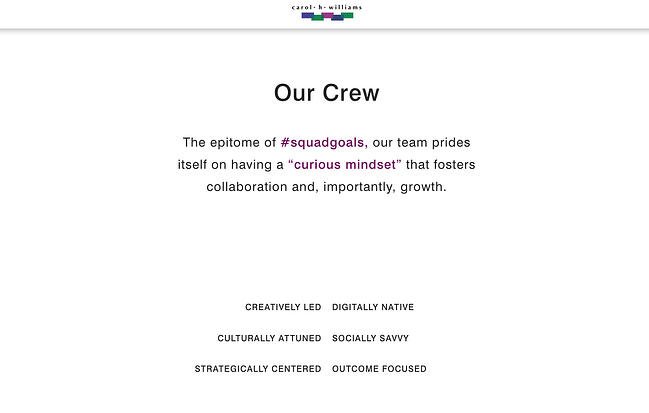What do your customers know about you? Do they know you sell products and have a website? That’s not always enough to build a brand identity that resonates with buyers and establishes your brand as the right choice.
People who find you online want to know about your company’s mission, vision, and, of course, how you can help them solve their problems. And, an impactful and memorable first impression can help you stand out in the digital world.
How can you make sure that they have all that information at their fingertips? Well, a company profile is the perfect tool for the job.

In this article, we’ll discuss:
A company profile serves multiple purposes, but two of its primary goals are to connect with customers and attract investors for funding opportunities.
Why Company Profiles are Important
Company profiles go a step beyond the standard “about” page. They share how your company got started — and why you continue to serve customers.
Here are some of the reasons why having a company profile is important:
1. A company profile differentiates your brand.
A company profile describes what makes your company unique. It automatically differentiates your brand because no other company has the exact same founding story and reason for existing that your business does. Your history and values are integral parts of your brand positioning strategy, and a company profile is where you can mention this information without it feeling extraneous or out of place.
2. A company profile may justify a higher price point.
You can justify a higher price point for your products and services, if you go into details about your production values or ethically-sourced materials.
For instance, Starbucks’ coffee may not necessarily be better than Dunkin’ Donuts’ coffee, but because Starbucks goes into details about its high-quality ingredients, it immediately creates the sense that you’ll be paying a little more for a “better” product.
3. A Company profile builds your reputation.
What do you want your company to be known for?Is your company the one that started as a small family-owned shop that grew into a billion-dollar enterprise? Or is it a company that upholds sustainability and puts ethics at the forefront of its brand? You can build your reputation through marketing, service, and sales campaigns, but it all begins with a well-curated first impression.
Now that you understand the importance of a company profile, it’s time to learn how to write one. Creating a company profile doesn’t have to be nerve-wracking. In fact, it can actually be rather straightforward.
Here are ten steps to guide you on how to write your company profile.
1. State the purpose of the company profile.
This is the most critical part when writing an effective company profile. You want to make sure that the statement aligns with what you’re trying to accomplish. For instance, if your goal is to attract investors, you can include:
- Your business’s performance
- The value of the products you sell
- The company’s revenue
On the other hand, if you want to attract customers, it’s best to add the company values to your profile.
The purpose of a company profile should act as your guide throughout the process, so take your time on it.
2. Decide on the format or style.
How you present your profile significantly affects how successful it is. It’s important that the style offers excellent readability and encourages the audience to engage with it.
This depends on your audience – for example, it’s best to stick to the traditional format for an accounting firm. That is, list the company’s achievements and awards.
On the other hand, if you’re in a fashion or social media marketing firm, it’s advisable to be creative and visual. Byte/Dept, for example, is a marketing technology company with a creative and visual homepage that is in line with what it offers.

Don’t be afraid to experiment or go wild with your ideas as long as they resonate with your target audience.
3. Tell your story & be authentic.
There are probably a million other businesses that sell what you’re selling, but no one else shares your story. Your story is what makes you unique. Don’t just write numbers and dates; let your prospects know who you really are. Be vulnerable and tell them why you started your business.
What inspired you? Share the bad and the good – it doesn’t have to be glamorous. It only has to be authentic.
4. Add your company’s mission statement.
If you don’t have a mission statement, it’s time to craft one. Writing a mission statement for your company isn’t as scary as it sounds, and there is no need to overthink it. You only need to ask yourself these three questions:
- Who you serve – this is your target consumer
- How do you do it – what product or service do you provide to solve their problems?
- What makes you different – why should your consumers buy from you or trust you over your competitors?
5. Write your company’s history.
This needs to be in chronological; otherwise, it will confuse your readers. You can do it in a paragraph or a timeline format as long as it shows a flow.
Another tip is to remember that less can be more. As tempting as it is to share all your milestones, stick to the major ones to avoid overwhelming the reader.
6. Describe the products and services you offer.
The next step is to describe what your company offers. You can choose a few of your best products or services and give an in-depth description or simply list down everything your business offers.
7. Name the awards your company has received.
If you have received any awards or recognition, add them to your profile and describe them. They showcase your company’s values and give the community a reason to trust you.
8. Add your customer’s testimonials.
Your customers may take everything you say with a grain of salt, but they will believe other customers who have used your products. This is an excellent way to promote your business without having your products or services come off as hard-sell.
If you’re a B2C business, simply include some of your customer’s best quotes, tied with your best value products. If you’re a B2B business, have a testimonial from the most prominent client on your profile.
Hedley & Bennett, a restaurant wear company, features customer reviews and testimonials on its homepage.

9. Include a call to action.
This isn’t mandatory, but it’s a nice touch to your company’s profile. What do you want the readers to do after reading the profile? Visit your branch, check out your website, or call you? Simply include it at the end of your profile. This brings us to our last step.
10. Add your company’s contact information.
This is one of the most critical parts of the company profile. Include all the possible ways your prospects can reach you. This may include but is not limited to; social media profiles, websites, phone numbers, fax, email, and physical address.
Make sure it’s visible to anyone who reads your company profile.
Company Overview Template
Now that we have gone through all the necessary steps you need to create a company profile, it’s time to put all that into action. Here is a simple company overview template that will help you get started.
Our Story
[Company name] was founded in [Year], and we have accomplished so much over the years. To create a world where [ the solution your business solves] has always been our goal.
Our Founder and CEO [Name] was inspired to start this company by [ one or two sources of inspiration].
At [Company Name], we encourage our community to [ a positive statement related to your brand].
Meet our Team
[Photo] [Name] [Job Title]
[Photo] [Name] [Job Title]
[Photo] [Name] [Job Title]
Our Mission, Vision & Values
Mission
Our goal is to provide our customers with the best [ service or product] at the best possible market price without compromising quality.
Vision
To be the most reliable [ service or product] provider and enhance [what your product or service does].
Core values
[List your company’s core values]
What Our Customers are Saying
[Insert customer’s testimonials]
Contact Information
Location
Website URL
Social Media Pages
Cell Number
Company Profile Examples

Starbucks’ company profile has it all — its mission, background story, products, store atmosphere, and even folklore regarding the name. Best of all, they manage to pull off sounding genuine and grandiose. I don’t know many other coffee stores that could claim that their mission is “to inspire and nurture the human spirit.”
Starbucks’ company profile is a fantastic example of a store with a common household product: coffee. Starbucks managed to stand out from the competition through its mission and values.

If your company has an exciting and intellectual history, you might consider creating a profile like Wales Bonner’s. It begins with an impactful statement: “Wales Bonner proposes a distinct notion of cultural luxury that infuses European heritage with an Afro Atlantic spirit. Launched by Grace Wales Bonner following her graduation from Central Saint Martins in 2014, the label is informed by broad cultural research and embraces a multiplicity of perspectives.”
After sharing the brand’s intellectual background, it describes the owner’s journey in building the company, starting from the time she was a college student, as well as the accolades she has received through her ingenuity in design. With a good balance of image and text, the timeline serves as a reminder of Wales Bonner’s stability and growth.

For both cleanliness and ease-of-use, take a look at Diehl Group Architects’ company profile. The web page uses clickable boxes to separate topics, allowing users to choose which subject they’d like to learn more about.Additionally, the entire design mirrors the company’s purpose, including the page’s background, which displays a floor plan.

Consumers use video as an integral part of their journey with brands, so you might consider using a compelling video to convey your company’s story as Bloomberg does in its company profile.
Bloomberg’s profile proves the company knows its audience because they offer quick statistics and links to other areas of the site, such as Careers and Tech. While other businesses might do well in offering a creative, long-form story, Bloomberg’s typical demographic is likely more analytical.
 You can get a sense of Nike’s two primary purposes almost instantly — fitness, people, and inclusion.
You can get a sense of Nike’s two primary purposes almost instantly — fitness, people, and inclusion.
When you land on its website, you’re greeted by a bold statement: “Bring inspiration and innovation to every athlete* in the world.” The asterisk implies, “If you have a body, you are an athlete.” As you scroll, you’ll see information on its internal diversity and inclusion initiative, global community impact, and sustainable business program, with very little mention of its products.
Nike’s company profile portrays a larger, grander vision, compelling an audience to believe in its brand before purchasing a product.

Seattle Cider Company’s profile is minimal and engages viewers through compelling animations that demonstrate the company’s cider selection. The page flows seamlessly and provides critical information regarding the product before displaying the company’s mission and values. This profile is a good example of a company that understands its users’ concerns (in this case, quality ingredients), and addresses those issues while still displaying personality and flair.

Delta’s page is well-organized by topic and showcases the company’s values, including efforts to engage with the community and promote sustainability. It includes brief meta-descriptions below each category, and the design allows users to click through to learn more. Overall, Delta’s company profile is simple and uncluttered but includes all the necessary information to demonstrate why it’s unique.

Roam Loud’s company profile is a great example and inspiration for any brand that has a personal story. It’s simple yet effective, starting with a friendly greeting, “Hey there!” and ending with a list of values. In between, the founder clearly states why she created her brand and why its existence is important to her and prospective buyers.

MAD Architects’ company profile is a great example of simplicity and informativeness. The profile isn’t shy about the firm’s accomplishments and lets readers dive deeper into the firm’s exhibitions, lectures, awards, and publications, all visible on different tabs on the same page. By leaning into a strong brand voice and giving details about its service, customers have the information they need to decide for themselves.
If your business is a leader in your field, consider creating one similar to MAD Architects.

Topicals is a skincare company that provides products and education to help people target and learn about flare-ups. It has a one-of-a-kind about us page that is interactive and provides a fun experience for site visitors.
When you land on the page, you immediately see multiple interactive cards, the first of which features a description of its mission. Once you’re done reading about its purpose, you can learn more about the company by clicking on the other cards, or simply selecting the information that is most relevant to your needs.
Examples of Company Descriptions
Here are some examples of company descriptions that enhance their organizations’ company profile.

On HubSpot’s profile page, you’ll find a brief description of the company’s mission and what it does. In just a few words, HubSpot explains that the company’s goal is to help businesses grow through its specialized inbound software.

Landed, Inc’s About Us page begins with a brief description that explains why it exists: “Buying a home is more than a milestone, it’s a key to building a strong financial future.” From there, it talks about its mission, how it helps people buy homes, and a brief company history and description.

In the “Why Zaneilia” page of its website, the founder of H&H Wealth briefly introduces what she believes in and encourages her customers to walk the journey with her. She also makes a promise to her clients, setting expectations and the tone for the service she’ll deliver, helping her and her business come across as a partner rather than a vendor.

Dope Coffee aims to bridge the gap between coffee, hip hop, and culture to uplift the Black community. Its website describes the company’s history and mission, but a single line sticks out as a powerful and impactful description of its business to take inspiration from: “We are Dope Coffee Company, and we are changing the world one cup of coffee at a time.”

Authentique Agency provides the perfect amount of information upfront to describe what it is and its mission and values — leveraging the power of identity in brand campaigns that reflect cultural identities rather than erasing them. It’s a great example of how to quickly and succinctly get your message across to site visitors.

The Cru is a service that connects members with like-minded women to fuel personal and professional growth. It uses an “Our Story” page as a company profile, where the founder details how she formed the organization and how she owns “Cru” (a play on the word “crew”). This summary is a testament to the value of the service. The “letter from the founder” style also feels very personal and welcoming.

H.J Russell & Company opens up its description with its history and specialties: “H. J. Russell & Company, founded over 70 years ago, is a vertically integrated service provider specializing in real estate development, construction, program management, and property management.” It also makes its values clear in the last sentence, so you get a snapshot of the company’s key proposition and leadership status in just a few sentences. It also includes critical numbers that inform people of its expertise, from the number of projects completed to the properties it manages.

Carol H. Williams, an advertising agency, doesn’t have an “about” page or a formal company description. However, it displays a snapshot of what the company is all about on its “Team” page. It emphasizes its core values and uses trendy language (“#squadgoals”) to establish that it keeps up with the current trends.

Cafe Con Libros doesn’t have an about us page, but it does have a company description that clearly explains its mission and values in two short sentences: “Cafe con Libros (coffee with books) is an Intersectional Feminist community bookstore and coffee shop. Through our choice of books, programming, and great coffee, we endeavor to create a vibrant community space where everyone; specifically womxn-identified folx, feel centered, affirmed and celebrated.”

Custom Collaborative helps no/low-income immigrant women build entrepreneurship skills that help them succeed in sustainable fashion. Its about us page features essential need-to-know information for anyone looking to them for support, interested in donating to the cause, or simply looking to learn more about the business.
Company Profile Templates

Download These Templates for Free
- Company name
- Established date
- Physical address per location
- Contact information
About Us / Our Story / Our Beginning
In this part of the company profile, you will need to include a brief introduction to your company, including where, when, and by whom the company was founded, the company’s mission statement, and/or the company’s vision and purpose. You don’t necessarily have to include products or services in this section yet, but focus on your bigger meaning, and how you stand out from competitors instead. Tell your story in a compelling way. For instance, HubSpot starts their About Us section with, “More than ten years ago, we had a vision — an inbound world”. HubSpot doesn’t mention their products until further down the page.
If you want to add your company history in a more compact way, consider adding a company timeline, like this one:

Download This Template
Our Mission / Values
Here, you need to say what your company stands for on a larger scale. You can state your ultimate goal, and your hopes for your products or services. Take a look at these inspiring company vision and mission statement examples for ideas. Here’s an example:

Download This Template
Our Team
Provide a picture or brief paragraph describing your tea.You can focus on leadership, or provide an explanation of your company’s culture. Ultimately, this section should help users understand how your employees can uniquely serve them.

Download This Template
Our Product / Services
Describe a high-level overview of what your product is, and how you hope it will positively impact the user’s life. You can link to a Product page if necessary, so keep this section relatively general.
Start Your Company Profile Today
There are a few elements that can contribute to a stellar company profile, and by adhering to a template, you can build one quickly and effectively.
Editor’s Note: This post was originally published in January 2019 but has been updated for comprehensiveness.






![]()














![Download Now: The State of Media & Content Planning in 2022 [Free Data Report]](https://i4lead.com/wp-content/uploads/2022/12/de152c7c-795e-486a-aa66-d6985ffbc1cf.png)



![Download Now: Free State of Marketing Report [Updated for 2022]](https://i4lead.com/wp-content/uploads/2022/12/b0f73a5e-16e4-41fd-9511-8564efc560a7-4.png)
 Although this is just a shift in aesthetics, it points to a bigger trend with young consumers: they crave authenticity from brands. In other words, snapshots of avocado toast and heavily filtered selfies won’t cut it. Instead, brands must explore how to appear more accessible and relatable online.
Although this is just a shift in aesthetics, it points to a bigger trend with young consumers: they crave authenticity from brands. In other words, snapshots of avocado toast and heavily filtered selfies won’t cut it. Instead, brands must explore how to appear more accessible and relatable online.























 You can get a sense of Nike’s two primary purposes almost instantly — fitness, people, and inclusion.
You can get a sense of Nike’s two primary purposes almost instantly — fitness, people, and inclusion.


















![Download Now: Nonprofit Marketing & Fundraising Trends for 2022 [Free Report]](https://i4lead.com/wp-content/uploads/2022/12/6193b715-2ba9-4c6d-add0-681edfcae689.png)
















